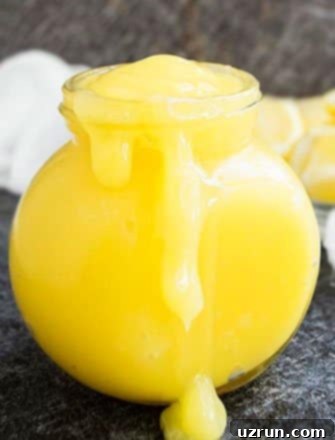Easy 4-Ingredient Lemon Curd Recipe: Homemade, Creamy & Zesty Perfection
Unlock the secret to creating a truly delightful dessert staple with our incredibly easy and quick **lemon curd recipe**. Requiring just four essential ingredients, this homemade treat strikes the perfect balance between sweet and subtly tart, making it an indispensable component for countless culinary creations. Whether you’re looking for a vibrant filling, a luscious topping, or a bright spread, this creamy lemon curd delivers exceptional flavor and texture with minimal effort.
This simple recipe utilizes ingredients you likely already have on hand, transforming them into a burst of sunshine. The irresistible sweet and sour combination makes it a perfect choice for a refreshing summer treat, ideal for enhancing various baked goods or even a scoop of ice cream. If you share my passion for all things lemon, be sure to explore our related recipes for a dazzling Lemon Glaze and a luxurious Lemon Frosting to elevate your favorite dishes even further.
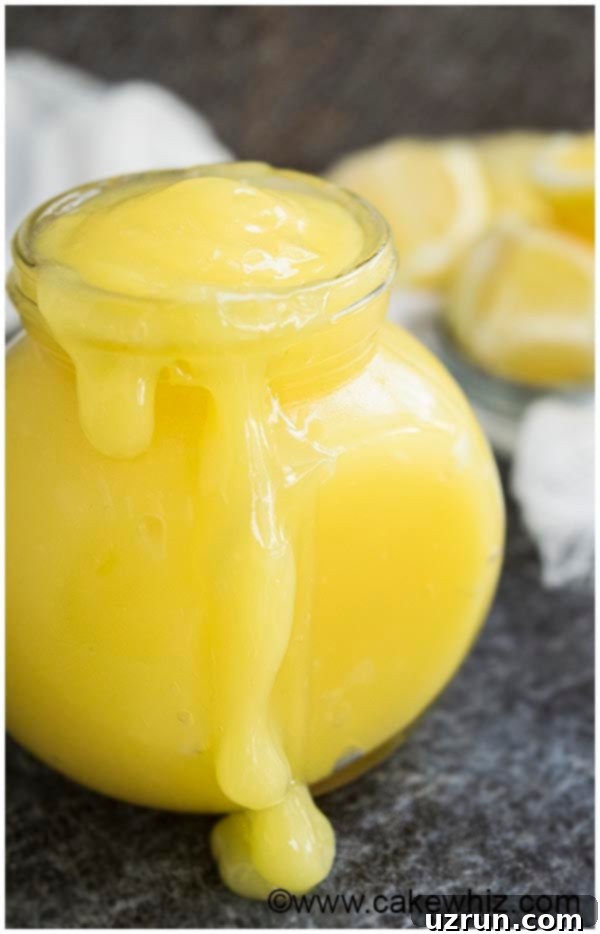
Why You’ll Adore This Easy Lemon Curd Recipe
There are countless reasons why this particular lemon curd recipe stands out and will quickly become a favorite in your kitchen:
- Simplicity: With only 4 core ingredients, it’s incredibly straightforward to make, even for novice bakers.
- Speed: From start to finish, you can have a fresh batch of tangy lemon curd in under 20 minutes.
- Vibrant Flavor: Using fresh lemons ensures a bright, zesty, and authentically citrusy taste that store-bought versions can’t match.
- Versatility: Its applications are endless – from sophisticated dessert fillings to a simple, delightful toast spread.
- Smooth & Creamy Texture: The method guarantees a perfectly smooth, rich, and velvety curd every time.
- No Special Equipment: A saucepan and a whisk are primarily all you need, making it accessible for any home cook.
Say goodbye to artificial flavors and hello to the pure, unadulterated taste of homemade lemon goodness!
How to Make Easy Lemon Curd from Scratch
Making a luscious batch of homemade lemon curd is surprisingly simple. Follow these straightforward steps to achieve a perfectly smooth and zesty result:
- Prepare the Lemons: Begin by zesting all your fresh lemons, being careful to only get the bright yellow part and avoid the bitter white pith. Then, juice the lemons. This fresh zest and juice are crucial for an intense lemon flavor.
- Combine Ingredients: In a nonstick saucepan, combine the freshly squeezed lemon juice, aromatic lemon zest, cubed unsalted butter, granulated white sugar, and the separated egg yolks.
- Cook and Whisk: Place the saucepan over medium heat. Continuously whisk this mixture. Constant whisking is key to preventing the eggs from scrambling and ensuring a smooth, even consistency. Continue cooking for approximately 8-12 minutes, or until the mixture visibly thickens enough to coat the back of a spoon. It should have a consistency similar to pudding.
- Enhance Flavor and Color (Optional): Once thickened, remove from heat. Stir in about ½ teaspoon of lemon extract for an extra boost of lemon flavor, and a few drops of yellow food coloring if you desire a more vibrant hue. Mix thoroughly until evenly distributed.
- Cool and Store: Pour the hot lemon curd into a clean, sterilized glass jar or an airtight container. Allow it to cool completely at room temperature before transferring it to the refrigerator. The curd will continue to thicken as it cools.
Once chilled, your homemade lemon curd is ready to be enjoyed! This simple process yields a truly superior product compared to anything you’d buy in a store.
Key Ingredients for the Best Lemon Curd
Achieving a truly spectacular lemon curd starts with understanding the role of each ingredient. Here’s a breakdown of the essential components for our easy lemon curd recipe:
- Fresh Lemons: This is non-negotiable! Always use fresh, ripe lemons for both their juice and zest. Bottled lemon juice lacks the vibrant flavor and essential zest that gives homemade curd its characteristic brightness and depth. The zest contains essential oils that contribute significantly to the aroma and taste.
- Egg Yolks: We only use egg yolks in this recipe, as they are the primary thickening agent and provide the rich, creamy texture that defines lemon curd. The fat in the yolks also contributes to its silky mouthfeel. Using whole eggs can lead to a less rich texture and a slightly different flavor profile.
- Unsalted Butter: Good quality unsalted butter adds richness, smoothness, and a beautiful sheen to the curd. Using unsalted butter allows you to control the overall saltiness of the final product, ensuring it remains sweet and tart without any unwanted savory notes.
- Granulated Sugar: This provides the necessary sweetness to balance the tartness of the lemons. Granulated white sugar dissolves easily and contributes to the smooth texture without altering the flavor. You can adjust the amount slightly to suit your preference, but the recommended amount creates a perfect harmony.
These four simple ingredients, when combined with care, create a truly magical lemon curd that’s far superior to any store-bought alternative.
Versatile Uses for Your Homemade Lemon Curd
Once you’ve made a batch of this delightful lemon curd, you’ll find endless ways to incorporate its vibrant flavor into your culinary adventures. Here are some classic and creative uses:
- As a Topping: Drizzle it generously over breakfast items like fluffy Blueberry Pancakes, crispy Blueberry Waffles, or warm toast. It’s also fantastic spooned over Cranberry Orange Scones, vanilla ice cream, or delicate Crepes for an instant upgrade.
- Lemon Cupcakes: Transform ordinary cupcakes into extraordinary treats. Simply core the center of baked Lemon Cupcakes, fill with a spoonful of tangy curd, and then top with your favorite buttercream frosting for a delightful surprise.
- Lemon Cheesecake: Elevate a classic. Prepare this delicious New York Cheesecake, and once it has set, pour a smooth layer of lemon curd on top. Alternatively, swirl the curd directly into your cheesecake batter before baking for an incredibly zesty and visually stunning dessert.
- Lemon Cookies: Create elegant sandwich cookies. Bake a batch of soft Sugar Cookies and use the lemon curd as a vibrant, tangy filling between two cookies.
- Lemon Muffins: Add a burst of citrus to your morning. You can either fill the center of baked muffins (such as Blueberry Muffins) with curd, or thin the curd slightly with a touch of water or lemon juice to create a zesty drizzle. It also makes a wonderful spread directly on top of warm muffins.
- Lemon Cake: For a truly show-stopping dessert, bake a moist Lemon Cake. Once cooled, slice the layers in half and spread a generous amount of lemon curd between them, then finish with a rich buttercream icing.
- Lemon Tart: The quintessential use! Bake a flaky Pie Crust, allow it to cool, then fill it with the creamy lemon curd. Top it off with a delicate meringue or a dollop of fresh Whipped Cream. It’s also an essential component for a classic Lemon Meringue Pie.
- Breads: Incorporate lemon curd into various bread recipes. Use it as a filling for sweet rolls, swirl it within the dough before baking for a marbled effect, or simply use it as a flavorful spread on freshly baked slices. Try it with this delightful Orange Cranberry Bread for a citrusy twist.
Exciting Variations and Customizations
While classic lemon curd is a masterpiece on its own, don’t hesitate to experiment with these variations to customize your spread and create new flavors:
- Other Citrus Fruits: The beauty of this recipe lies in its adaptability. Use the same method to create a vibrant orange curd, a tangy tangerine curd, a slightly bitter grapefruit curd, or even a mixed berry curd like blueberry curd or a refreshing blueberry lemon curd. The possibilities for delicious concoctions are endless!
- Alternative Sweeteners: If you’re looking for different sweetness profiles or dietary alternatives, you can experiment with coconut sugar, sugar-free sweeteners, or other options. However, be mindful that liquid sweeteners like agave, honey, or maple syrup can alter the consistency and potentially thin out the mixture, requiring slight adjustments to the cooking time or the addition of a thickener.
- Egg Yolk Substitutions (for thickening): While egg yolks are traditional and contribute immensely to the flavor and texture, if you need an alternative for thickening, a few tablespoons of cornstarch can be used. Dissolve it in a small amount of cold water before adding it to the hot mixture. However, for the characteristic richness and taste, I personally prefer and recommend sticking with egg yolks.
- Microwave Method: For a super quick approach, you can cook the curd in the microwave. Combine all ingredients in a microwave-safe bowl and heat in 30-60 second intervals, whisking thoroughly after each, until thickened. Be very careful not to overcook, as it can scramble quickly. While convenient, I find the stove-top method offers more control for a perfectly smooth result.
- Flavor and Color Boosters: For an intensified lemon flavor and a more vivid appearance, consider adding a little bit of lemon extract and a few drops of yellow food coloring at the end of the cooking process. These are optional but can truly enhance both the taste and visual appeal.
Essential Tips for Perfect Lemon Curd Every Time
Achieving a consistently perfect, velvety smooth lemon curd is easy with these expert tips:
- Choose a Nonstick Saucepan: Using a nonstick saucepan is highly recommended. It helps prevent the curd from sticking to the bottom and burning, making the whisking process much smoother and clean-up easier.
- Always Use Fresh Lemons: This cannot be stressed enough! Store-bought bottled lemon juice simply does not compare in terms of flavor intensity or freshness. Moreover, it lacks the essential zest, which is crucial for the bright, aromatic notes in authentic lemon curd.
- Whisk Constantly: During the cooking process, continuous whisking is vital. This ensures the egg yolks cook evenly without scrambling and helps achieve that signature smooth, creamy texture.
- Understand Thickening: Don’t panic if your curd seems a bit thin when you first take it off the heat. Lemon curd naturally thickens considerably as it cools down in the refrigerator. Cook it until it coats the back of a spoon, then trust the chilling process.
- Strain for Silky Smoothness: For an exceptionally smooth and lump-free curd, consider straining the mixture through a fine-mesh sieve after cooking and before pouring it into jars. This removes any tiny bits of cooked egg or zest, resulting in a perfectly silky texture.
- Use Unsalted Butter: Stick to unsalted butter for this recipe. Using salted butter can result in a curd that is unexpectedly salty, throwing off the delicate sweet-tart balance.
- Canning Lemon Curd (Advanced): If you are experienced in proper canning techniques, this recipe can be adapted for canned lemon curd, extending its shelf life significantly. This is a great option for enjoying homemade curd for a longer period, but always follow approved canning guidelines for safety.
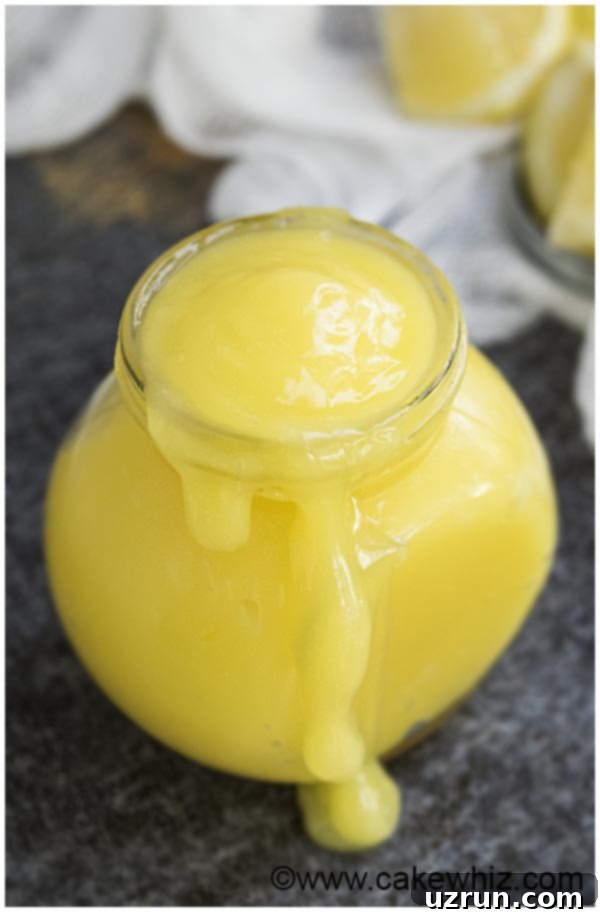
Lemon Curd vs. Lemon Custard vs. Lemon Pie Filling: What’s the Difference?
While often used interchangeably or confused, lemon curd, lemon custard, and lemon pie filling are distinct in their ingredients, preparation, and typical uses:
- Lemon Curd: Our focus here! Lemon curd primarily uses egg yolks as a thickener, along with butter, sugar, and lemon juice/zest. This results in a rich, intensely flavored, and often more “zesty” product with a smooth, velvety consistency. It’s typically used as a spread, topping, or filling.
- Lemon Custard: Custards generally use whole eggs (or sometimes just yolks) and a larger proportion of dairy (milk or cream) as their base. They are cooked until thickened to a softer, more jiggly consistency and are often served as a standalone dessert, like crème brûlée or baked custards, or as a component in trifles. The flavor tends to be milder and creamier than curd.
- Lemon Pie Filling: While it can sometimes use eggs, lemon pie filling typically relies on cornstarch (or flour) as its primary thickener. It often includes water and less butter than curd, resulting in a gel-like consistency that sets firmly when cooled, making it ideal for holding its shape in pies. The flavor tends to be less intense and “zesty” compared to true lemon curd.
In essence, lemon curd stands out for its concentrated lemon flavor, rich butter content, and smooth, spreadable texture achieved primarily through egg yolks.
Storage Tips for Freshness
Proper storage ensures your homemade lemon curd stays fresh and delicious for as long as possible:
- Refrigerator: Once cooled, transfer your lemon curd to a clean, airtight container or a sealed jar. It can be safely stored in the refrigerator for up to 1 week. Always ensure it’s tightly sealed to prevent it from absorbing odors from other foods.
- Freezer: For longer storage, lemon curd freezes beautifully. Spoon the cooled curd into sealed freezer bags (removing as much air as possible) or an airtight freezer-safe container, leaving about half an inch of headspace to account for expansion. It can be stored in the freezer for up to 3 months. To thaw, simply remove the container from the freezer and place it in the refrigerator for 24 hours, or until it softens and defrosts completely. Give it a gentle whisk after thawing to restore its smooth consistency.
Frequently Asked Questions About Lemon Curd
- Why isn’t my lemon curd thickening? This is often due to not cooking it long enough or not whisking consistently. Ensure you’re cooking over medium heat and whisking continuously until it visibly coats the back of a spoon. Remember, it will continue to thicken significantly as it cools in the fridge.
- Can I use a double boiler? Yes, using a double boiler is an excellent method for gentle, controlled cooking that minimizes the risk of scrambling the eggs. It might take slightly longer to thicken but provides a very smooth result.
- What can I do if my curd has lumps? If your curd ends up with small lumps (often from slightly scrambled egg), simply press it through a fine-mesh sieve after cooking. This will remove any imperfections and leave you with a perfectly smooth curd.
More Zesty Lemon Desserts to Explore
If you’ve fallen in love with the vibrant flavor of lemon, here are more irresistible lemon-infused desserts from our collection:
- Lemon Cake Balls {Cake Truffles}
- Lemon Fudge {2 Ingredients}
- Easy Lemon Cookies
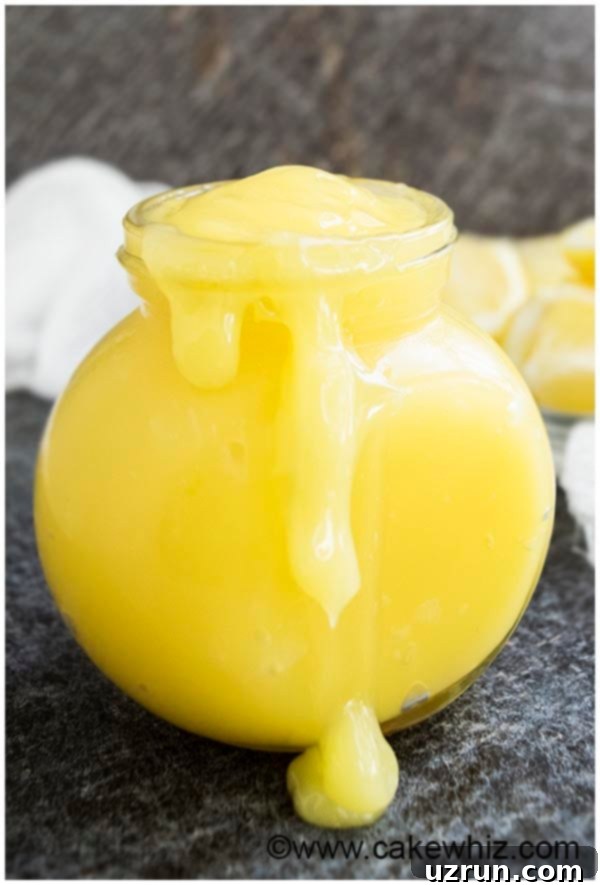
Recipe
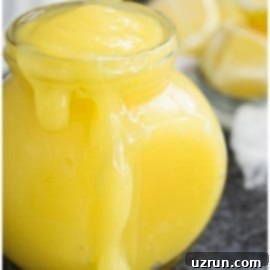
Lemon Curd Recipe
Abeer Rizvi
Pin Recipe
Want to Save This Recipe?
Enter your email & I’ll send it to your inbox. Plus, get great new recipes from me every week!
By submitting this form, you consent to receive emails from CakeWhiz
Ingredients
- 4 Large Lemons
- 5 Egg yolks
- ½ cup Unsalted Butter
- 1 cup Granulated sugar
- ½ teaspoon Lemon extract Optional
- Yellow food coloring Optional
Instructions
-
Zest and juice all the lemons.
-
Add lemon juice, lemon zest, butter, sugar and egg yolks in anonstick saucepan.
-
Cook at medium heat, while constantly whisking until the mixture thickens. This takes about 10 minutes.
-
Add lemon extract and a couple of drops of food coloring and mix thoroughly.
-
Pour it in a jar and let it cool down.
-
Once the curd has fully cooled down, store in the refrigerator. Enjoy!
Notes
- Refer to the detailed tips and techniques provided above in the main article for best results.
- Leftovers can be stored in a sealed container in the fridge for up to 1 week.
- For longer storage, lemon curd can be frozen for up to 3 months.
Nutrition
An automated tool is used to calculate the nutritional information. As such, I cannot guarantee the accuracy of the nutritional information provided for any recipe on this site.
